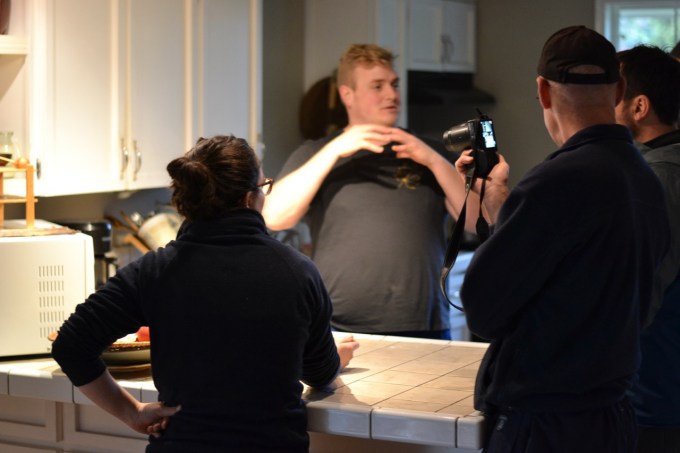East meets West: Chojubai on Riding Spur
This is a Japanese Flowering Quince Chojubai presented on a Western riding spur. ‘Presented?’ ‘Held’? ‘Lofted’? ‘Attached’? One might argue the proper term, but the riding spur was found on a hike in the Arizona mountains about 20 years ago, after falling off someone’s boot decades before. I’ve dragged it around everywhere I’ve lived, figuring it had an unknown future as part of something else. And that was revealed last week. When casting about in the garage for something to attach the chojubai to, my eyes settled on this ancient piece of ironsmithy…and the phrase ‘East meets West’ popped up, and I laughed, and there you have it. The latest bonsai orchid to grace our shade cloth structure was on its way to being born.
We had a great time making this, and throughout it all I wondered how old that riding spur actually was. It’s pretty dry there in Arizona and metal might last a while, and yet everything that used to move on it was rusted solid. So how old is that riding spur? 50 years old? 75? More? Any riders or blacksmiths out there care to make a guess?
The following is a photo essay of an afternoon going off into the aesthetic sunset during a Seasonal session. Enjoy-

Where we started: A chojubai root cutting, 7 years old, and a nicely rusted riding spur found in the mountains of Arizona, perhaps 50+ years old.

The riding spur attached to our plant support, a piece of nylon cutting board…

…using a propane torch to heat and bend the nylon…

Carmen is enjoying this torching part

Drilling holes for mounting

If you’re wondering why Andrew is teaching about muck making in the kitchen, you must attend a Seasonal session…

The nylon support, revised

John, Carmen, Zach, Tom, and Andrew involved in attaching the nylon thing to the plant thing. I kept out of the way.

Closeup of the operation

Zach using a persuader…a rawhide mallet that sees frequent use at repotting time

The planting inclination and front

Applying muck

And our final composition: East meets West. Not only is the support odd, the design is as well. There isn’t much a triangle to be found. So. The design elements here are circles, and we have three of them, small to large, left to right: Spur, Rootmass, Shrub. Hope you enjoy.
Here are two other ‘bonsai orchids’ that hang off our shade cloth structure, weather permitting:

13 Comments
Aint art fun!
It can be… should be…
More like this please. Definitely inspirational!
We will try to please your needs… ; )
Hi All,
We did have a lot of fun creating this one. I’m interested to know people’s opinion of it, a few have already commented. For me, this isn’t really bonsai. It has some elements of bonsai but not many, not enough of the structure, although the two other ‘bonsai orchids’ we’ve attempted have a shade more of bonsai structure, especially the Juniper. In the past these experimental play-days have been fun projects for Seasonal classes and with my apprentices Bobby and Andrew, and we learn a few things and there’s a fair bit of suggestions and consultations and teamwork which can be different, bonsai often being a very solitary art. Please comment freely-
Looks like you’re taking up the challenge of defining “American Bonsai” one tree at a time!
Good thoughts, It opens up an entire area of using uniquely American artifacts in design.
Ha! We’re just exploring. I never approach a project thinking, this will be a philosophical answer to this question…but rather, what would be an unusual visual solution to this aesthetic problem. But artifacts, ya. They are underused in presentation of a tree, outside of display where occasionally we see them.
I am sorry, but after 40 yrs of doing Bonsai. All this stuff does nothing for me. I am studying under Chris Baker the curator of the Chicago Botanic garden and Bonsai still is for me a Tree ion a tray.
I can understand that. About 95% of what we do here at Crataegus Bonsai is traditional bonsai, and I love that.
Why?
A fair question. As I mentioned in another reply, I don’t consider this bonsai. About 5% of what we do in my studio likely isn’t, we do some exploring, experimenting, and I do post these things on the blog. Students learn a few techniques and we have fun. We can certainly argue about what it is, though, and when pushing the boundaries of bonsai some things puncture through that boundary and aren’t bonsai any more. What that line is is an interesting conversation, and a good place to ask why.
Some further thoughts: One of the reasons this strikes me as a bit beyond what we can call bonsai, at least at this time, is that the riding spur introduced content well outside of what bonsai usually allows. A bonsai container or support or slab is content-less, or as much so as possible. It is a construct, a fiction, and a nearly blank one. The focus is on the tree. With this chojubai composition, the spur carries with it a gross ton of content. Visually it’s active, but also it’s historically weighty. This is the opposite of what bonsai tradition currently allows. It may well, amoeba-like, embrace things like this in the future, but I think it would be a stretch to say the main tradition includes this now. Still, it’s fun to play, for play is its own reward.
It’s different not my cup of tea but you have to try different ways that’s what keeps bonsai interesting.